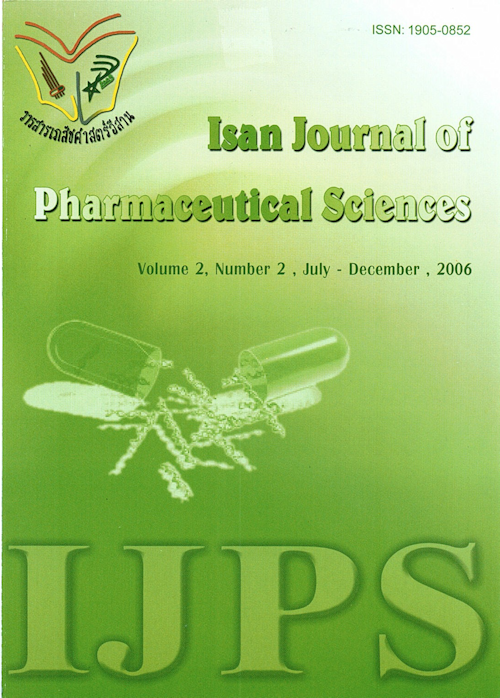Alginate-magnesium aluminum silicate composite
Main Article Content
Abstract
Alginate and magnesium aluminum silicate have been used as excipients in pharmaceutics. Alginate-magnesium aluminum silicate composite dispersions provided pseudoplastic flow with thixotropy because of an interaction of both materials. This led to a microcomposite formation of composite films. The composite films showed higher tensile strength and elongation, and lower drug permeability wnen compared with alginate films. The composite dispersions could be used as novel tablet coating material for modifying or sustaining drug release. Incorporation of hydrophilic plasticizers into the composite film could retard water vapor transmission and did not affect the drug permeability. Moreover, this composite could be applied to prepare small particle beads as well. Thus, alginate-magnesium aluminum silicate composite is a novel material to use as film and matrix former in pharmaceutics.
Article Details
In the case that some parts are used by others The author must Confirm that obtaining permission to use some of the original authors. And must attach evidence That the permission has been included
References
Al-Musa S., Fara D.A., Badwan A.A. (1999). Evaluation of parameters involved in preparation and release of drug loaded in crosslinked matrices of alginate. J. Control. Release 57: 223-232.
Badwan A.A., Abumalooh A., Sallam E., Abukalaf A., Jawan o. (1985). A sustained release drug delivery system using calcium alginate beads. Drug Dev. Ind. Pharm. 11: 239-256.
Bhagat H.R., Mendes R.W., Mathiowitz E.» Bhargava H.N. (1991). A novel selfcorrecting membrane coating technique. Pharm. Res. 8: 576-583.
Ciullo P.A. (1981). Rheological properties of magnesium aluminum silicate/xanthan gum dispersion. J. Soc. Cosmet. Chem. 32: 275-285.
Clare K. (1993). Algin. In Whistler R.L., Bemiller J.N., editors. Industrial gums: Polysaccharides and their derivatives, 3rd ed., New York: Academic Press. pl05-143.
Efentakis M., Buckton G. (2002). The effect of erosion and swelling on the dissolution of theophylline from low and high viscosity sodium alginate matrices. Pharm. Dev. Technol. 7: 69-77.
Fernandez-Hervas M.J., Holgado M.A., Fini A., Fell J.T. (1998). In vitro evaluation of alginate beads of a diclofenac salt. Int. J. Pharm. 163: 23-34.
stberg T., Graffner C. (1994). Calcium alginate matrices for oral multiple unit adminis-tration:III. Influence of calcium concen-* tration, amount of drug added and alginate characteristics on drug release. Int. J. Pharm. Ill: 271-282.
stberg T., Vesterhus L., Graffner C. (1993). Calcium alginate matrices for oral multiple unit administration: II. Effect of process and formulation factors on matrix properties. Int. J. Pharm. 97: 183-193.
Pongjanyakul T., Priprem A., Puttipipatkhachom S. (2005b). Influence of magnesium aluminium silicate on rheological, release and permeation characteristics of diclofenac sodium aqueous gels in-vitro. J. Pharm. Pharmacol. 57(4): 429-434.
Pongjanyakul T., Priprem A., Puttipipatkhachom S. (2005a). Investigation of novel alginatemagnesium aluminum silicate microcomposite films for modified-release tablets. J. Control. Release 107(2): 343-356.
Pongjanyakul T., Puttipipatkhachom S. (2006b). Aiginate-magnesium aluminum silicate films: effect of plasticizers on film properties, drug permeation, and drug release from coated tablets. Int. J. Pharm. (in press).
Pongjanyakul T., Puttipipatkhachom S. (2006a). Xanthan-alginate composite gel beads: molecular interaction and in vitro characterization. Int. J. Pharm. (in press).
Pongjanyakul T., Sungthongjeen S., Puttipipatkhachom S. (2006). Modulation of dmg release from glyceryl palmitostearate-alginate beads via heat treatment. Int. J. Pharm. 319: 20-28.
Puttipipatkhachom S., Pongjanyakul T., Priprem A. (2005). Molecular interaction in alginate beads reinforced with sodium starch glycolate or magnesiumaluminum silicate, and their physical characteristics. Int. J. Pharm. 293:51-62
Ray S.S., Okamoto M. (2003). Polymer/layered silicate nanocompositcs: a review from preparation to processing. Prog. Polym. Sci. 28: 1539-1641.
Rubio M.R., Ghaly E.S. (1994). In vitro release of acetaminophen from sodium alginate controlled release pellets. Drug Dev. Ind. Pharm. 20: 1239-1251.
Sirkia T., Salonen H., Veski P., Jurjenson H., Marvola M. (1994). Biopharmaceutical evaluation of new prolonged-release press-coated ibuprofen tablets containing sodium alginate to adjust drug release. Int. J. Pharm. 107: 179-187.
Sugawara S., Imai T., Otagiri M. (1994). The controlled release of prednisolone using alginate gel. Pharm. Res. 11: 272-277.
Wade A., Weller P.J. (1994). Handbook of pharmaceutical excipients, 2nd ed., London: The Pharmaceutical Press. p269-273, 428-430.


